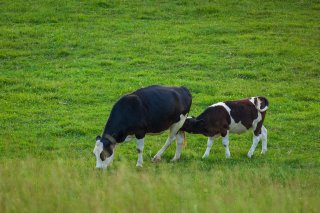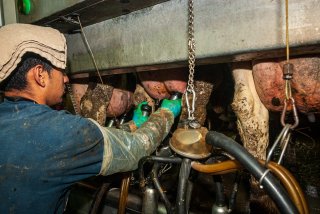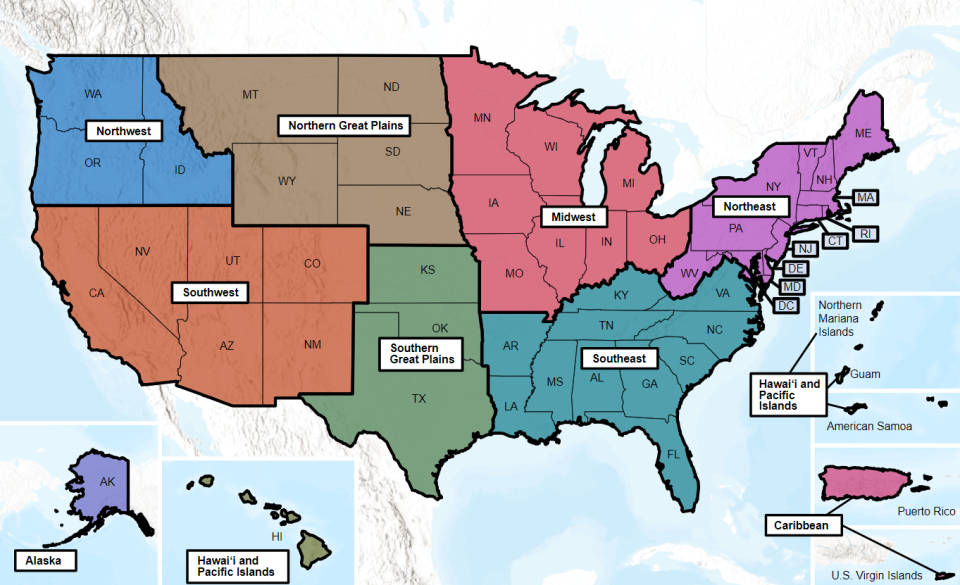Climate Change Connections: Wisconsin (Dairy Production)
Climate change is impacting all regions and sectors of the United States. The State and Regional Climate Change Connections resource highlights climate change connections to culturally, ecologically, or economically important features of each state and territory. The content on this page provides an illustrative example. As climate change will affect each state and territory in diverse ways, this resource only describes a small portion of these risks. For more comprehensive information about regional climate impacts, please visit the Fifth National Climate Assessment and Climate Change Impacts by Sector.
On this page:
Introduction: Dairy Is a Major Part of Wisconsin’s Cultural Identity and Economy

Wisconsin is known as America’s Dairyland for the major role dairy plays in the state’s economy and culture. Wisconsin is home to over 5,000 dairy farms and nearly 1.3 million cows, which works out to be about one cow for every five residents.1,2 The dairy cow is the state’s official domestic animal and milk is the state’s official beverage. About 90 percent of the milk produced by Wisconsin dairy farmers is used to make cheese.3 The state produces over 600 varieties of cheese and is responsible for nearly half of the U.S. domestic specialty cheese production.4 In 2022, Wisconsin produced 25 percent of U.S. domestic cheese (3.5 billion pounds), which is about the weight of over 2 million dairy cows.5 Overall, the dairy industry contributes over $45 billion to Wisconsin’s state economy each year.1 Dairy farming and dairy production supports a variety of jobs, including feed production, dairy equipment manufacturing, veterinary work, milk hauling, and dairy management software programming.
Climate Impacts: Warming Temperatures Threaten Dairy Production
During hot and humid summers, dairy cows are particularly vulnerable to heat stress,6 which occurs when the cows cannot easily cool down either through sweating or air circulation from wind or fans. Heat-stressed lactating cows eat less, are more prone to sickness, produce less milk, and have less-successful pregnancies.6 Extreme heat events can even kill cows. Although there haven’t been any major recorded cattle deaths related to heat stress in Wisconsin, the state observed temperatures close to and over 100°F in 2022.7 The ideal ambient temperature for dairy cows falls roughly between 32°F and 77°F.8 When conditions are too hot and humid, dairy cows can experience severe heat stress, which has been shown to decrease milk production.8
With continued climate change, Wisconsin is expected to stay warmer for more of the year.9,10 Between 1981 and 2010, Wisconsin experienced less than 20 hot days (days that reach or exceed 90°F) per year on average.9 By 2060, the number of hot days is projected to increase to 20 to 40 days on average.9

In the Midwest, warming temperatures are affecting livestock production, as heat stress can limit dairy quality.11 Research shows that a 1.5°F temperature increase could result in the equivalent loss of dairy output from one and a half cows on an average Wisconsin dairy farm.12 Projections show that such temperature increases are possible by 2030, which could result in a minor reduction of U.S. milk production.13 While warmer summer temperatures could put extra stress on dairy cows, warmer winters may reduce cold-related stress and be beneficial for milk production.14 Under projected scenarios of intermediate and high concentrations of greenhouse gases, without adaptation measures, climate impacts on dairy production are expected to increase by 2050.11
Wisconsin is also expected to receive more rainfall and more intense precipitation events in the coming decades.9,10 Research shows that an increase in rain during the spring and winter months is detrimental to milk production, as wet conditions can alter the behavior and physiology of cows.14,15 Wet and muddy environments can promote more pathogens and bacteria, making cows more prone to disease and infections.
Taking Action: Preparing for Warming Temperatures
Addressing climate change requires reducing greenhouse gas emissions while preparing for and protecting against current and future climate impacts. Communities, public officials, and individuals in every part of the United States can continue to explore and implement climate adaptation and mitigation measures. Livestock both experience climate impacts and contribute to greenhouse gas emissions, particularly methane emissions.16 As a source of greenhouse gas emissions, the livestock industry is in a unique position to increase resilience to the very changes in climate that it contributes to.16 Farmers are taking steps to build a more resilient dairy industry in a changing climate, including:
- Ventilation and cooling. To mitigate heat stress, dairy operators and farmers can use infrastructure to help with cooling, including ventilation and shade structures.13 Ventilation systems that provide fast-moving air in dairy facilities can help keep the cows cool by reducing stagnant, warm, humid air.17 Planting more trees for shade can support cooling for grazing livestock.18 Minimizing close bunching of cows in holding pens can also help to ensure adequate airflow and cooling.17 Installing water sprinkling system (e.g., misting or soaking) can also help dissipate heat.8,19 Expanding or constructing new systems can be expensive, so adaptation measures may be challenging to implement for some operations.
- Hydration and feeding adjustment. As temperatures continue to increase due to climate change, dairy farmers will need to further manage conditions to help reduce heat stress in their cows. Farmers can supply ample water to help keep cows hydrated. Heat stress can affect appetite, so operators may compensate by adjusting feed content for more concentrated nutrition and feeding schedules to avoid hotter parts of the day.13
To learn more about climate change impacts in Wisconsin and the Midwest region, see Chapter 24 of the Fifth National Climate Assessment.
Related Resources
- EPA Climate Change Indicators: U.S. and Global Precipitation
- EPA Climate Change Indicators: U.S. and Global Temperature
- Climate Hubs: Dairy (U.S. Department of Agriculture)
- Wisconsin State Climate Summary 2022 (NOAA)
References
1 Wisconsin Department of Agriculture, Trade and Consumer Protection. (2024). Wisconsin agricultural statistics. Retrieved December 22, 2023, from https://datcp.wi.gov/Pages/Publications/WIAgStatistics.aspx
2 U.S. Census Bureau. (2022). QuickFacts: Wisconsin [Data set]. https://www.census.gov/quickfacts/WI
3 Deller, S. C. (2019). The contribution of agriculture to the Wisconsin economy: An update for 2017. University of Wisconsin-Madison, Department of Agricultural and Applied Economics, Center for Community Economic Development. https://economicdevelopment.extension.wisc.edu/files/2019/08/Contribution-of-Ag-to-WI-Econ-4-Update.pdf
4 Wisconsin Department of Agriculture, Trade and Consumer Protection. (n.d.). Wisconsin Milk Marketing Board (dba Dairy Farmers of Wisconsin). Retrieved December 22, 2023, from https://datcp.wi.gov/Pages/AgDevelopment/MilkBoard.aspx
5 U.S. Department of Agriculture & National Agricultural Statistics Service. (2023). Wisconsin Ag News – Dairy products 2022 summary. Retrieved December 22, 2023, from https://www.nass.usda.gov/Statistics_by_State/Wisconsin/Publications/Dairy/2023/WI-Annual-DairyProducts-04-23.pdf
6 Polsky, L., & von Keyserlingk, M. A. G. (2017). Invited review: Effects of heat stress on dairy cattle welfare. Journal of Dairy Science, 100(11), 8645–8657. https://doi.org/10.3168/jds.2017-12651
7 NOAA National Weather Service. (n.d.). Monthly yearly climate graphs. NOAA’s National Weather Service. Retrieved December 22, 2023, from https://www.weather.gov/mkx/climategraphics?n=climategraphics
8 Liu, J., Li, L., Chen, X., Lu, Y., & Wang, D. (2019). Effects of heat stress on body temperature, milk production, and reproduction in dairy cows: a novel idea for monitoring and evaluation of heat stress — A review. Asian-Australasian Journal of Animal Sciences, 32(9), 1332–1339. https://doi.org/10.5713/ajas.18.0743
9 Wisconsin Initiative on Climate Change Impacts. (2020). Trends and projections. University of Wisconsin-Madison. Retrieved December 22, 2023, from https://wicci.wisc.edu/wisconsin-climate-trends-and-projections/
10 Frankson, R., Kunkel, K. E., Champion, S. M., & Sun, L. (2022). Wisconsin state climate summary 2022 (NOAA Technical Report NESDIS 150-WI). NOAA National Environmental Satellite, Data, and Information Service. https://statesummaries.ncics.org/chapter/wi/
11 Wilson, A. B., Baker, J. M., Ainsworth, E. A., Andresen, J., Austin, J. A., Dukes, J. S., Gibbons, E., Hoppe, B. O., LeDee, O. E., Noel, J., Roop, H. A., Smith, S. A., Todey, D. P., Wolf, R., & Wood, J. D. (2023). Ch. 24. Midwest. In A. R. Crimmins, C. W. Avery, D. R. Easterling, K. E. Kunkel, B. C. Stewart, & T. K. Maycock (Eds.), Fifth National Climate Assessment. U.S. Global Change Research Program. https://doi.org/10.7930/NCA5.2023.CH24
12 Njuki, E., Bravo-Ureta, B. E., & Cabrera, V. E. (2020). Climatic effects and total factor productivity: econometric evidence for Wisconsin dairy farms. European Review of Agricultural Economics, 47(3), 1276–1301. https://doi.org/10.1093/erae/jbz046
13 Key, N., Sneeringer, S., & Marquardt, D. (2014). Climate change, heat stress, and U.S. dairy production (ERR-175). U.S. Department of Agriculture, Economic Research Service. https://www.ers.usda.gov/publications/pub-details?pubid=45282
14 Qi, L., Bravo-Ureta, B. E., & Cabrera, V. E. (2015). From cold to hot: Climatic effects and productivity in Wisconsin dairy farms. Journal of Dairy Science, 98(12), 8664–8677. https://doi.org/10.3168/jds.2015-9536
15 Stull, C. L., Messam, L. L., Collar, C. A., Peterson, N. G., Castillo, A. R., Reed, B. A., Andersen, K. L., & VerBoort, W. R. (2008). Precipitation and temperature effects on mortality and lactation parameters of dairy cattle in California. Journal of Dairy Science, 91, 4579–4591. https://doi.org/doi:10.3168/jds.2008-1215
16 Bolster, C. H., Mitchell, R., Kitts, A., Campbell, A., Cosh, M., Farrigan, T. L., Franzluebbers, A. J., Hoover, D. L., Jin, V. L., Peck, D. E., Schmer, M. R., & Smith, M. D. (2023). Ch. 11. Agriculture, food systems, and rural communities. In A. R. Crimmins, C. W. Avery, D. R. Easterling, K. E. Kunkel, B. C. Stewart, & T. K. Maycock (Eds.), Fifth National Climate Assessment. U.S. Global Change Research Program. https://doi.org/10.7930/NCA5.2023.CH11
17 Van Os, J., & Halbach, T. (n.d.). Heat stress abatement in dairy facilities. University of Wisconsin-Madison Extension Dairy Program. Retrieved December 22, 2023, from https://dairy.extension.wisc.edu/articles/heat-stress-abatement-in-dairy-facilities/
18 Mayerfeld, D., Akins, M., & Os, J. V. (n.d.). Dealing with hot weather in grazing systems. Dairy. Retrieved August 14, 2024, from https://dairy.extension.wisc.edu/articles/dealing-with-hot-weather-in-grazing-systems/
19 Armstrong, J., & Janni, K. (2023). Heat stress in dairy cattle. University of Minnesota Extension. Retrieved January 24, 2024, from https://extension.umn.edu/dairy-milking-cows/heat-stress-dairy-cattle

